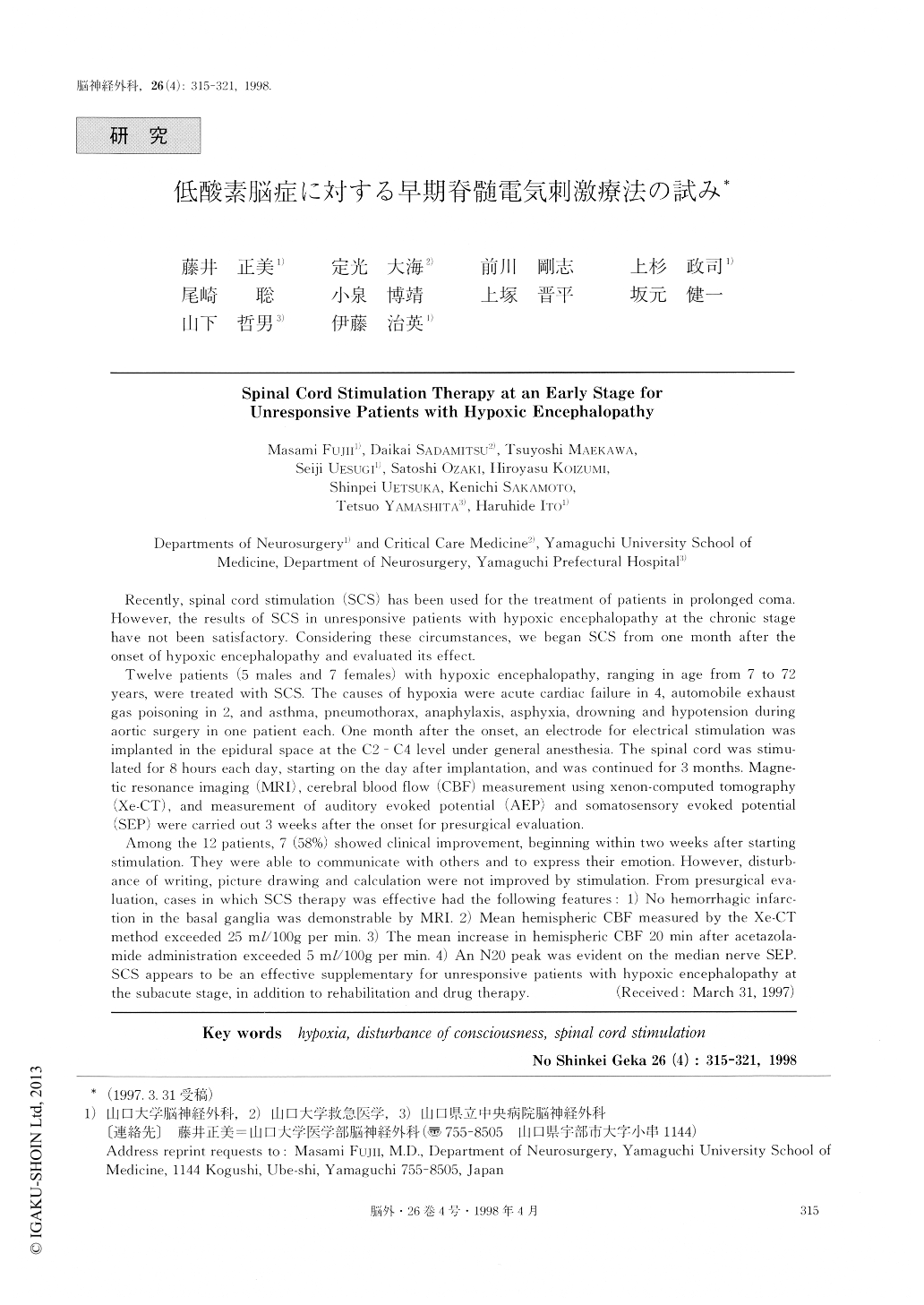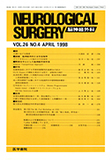Japanese
English
- 有料閲覧
- Abstract 文献概要
- 1ページ目 Look Inside
I.はじめに
蘇生術の進歩により,多くの急性呼吸循環不全患者が救命され,生存率は向上している.しかし蘇生後生存しえても全脳虚血に伴う意識障害が長期に持続する症例も多い.そして全脳虚血によりもたらされた意識障害を中心とする神経学的所見の異常は低酸素脳症とされ,全脳虚血の程度により差はあれ,予後は一般に不良である1,5,8,18).その予後不良の一因は,急性期を過ぎると低酸素脳症に対する有効な治療法がないことがあげられる.また一方,近年頭部外傷などによる遷延性意識障害に対し脊髄硬膜外電気刺激(SCS)療法が行われ有効例が報告されている6,9,15,19,20).そして発症3カ月以降の慢性期の低酸素脳症に対してもSCS療法が行われているが,その効果は満足する結果とは言えない9).しかし,SCS療法の実験的有効性,および種々の疾患による慢性期意識障害症例での有効性が報告されていることから,低酸素脳症例においても,有効な治療法のない亜急性期にSCS療法を行えば,より良い効果が得られることが期待される.そこで今回われわれは発症1カ月目の亜急性期にSCS療法を開始し,その効果と限界につき検討し報告する.
Recently, spinal cord stimulation (SCS) has been used for the treatment of patients in prolonged coma.However, the results of SCS in unresponsive patients with hypoxic encephalopathy at the chronic stagehave not been satisfactory. Considering these circumstances, we began SCS from one month after theonset of hypoxic encephalopathy and evaluated its effect.
Twelve patients (5 males and 7 females) with hypoxic encephalopathy, ranging in age from 7 to 72years, were treated with SCS. The causes of hypoxia were acute cardiac failure in 4, automobile exhaustgas poisoning in 2, and asthma, pneumothorax, anaphylaxis, asphyxia, drowning and hypotension duringaortic surgery in one patient each. One month after the onset, an electrode for electrical stimulation wasimplanted in the epidural space at the C2 - C4 level under general anesthesia. The spinal cord was stimu-lated for 8 hours each day, starting on the clay after implantation, and was continued for 3 months. Magne-tic resonance imaging (MRI), cerebral blood flow (CBF) measurement using xenon-computed tomography(Xe-CT), and measurement of auditory evoked potential (AEP) and somatosensory evoked potential(SEP) were carried out 3 weeks after the onset for presurgical evaluation.
Among the 12 patients, 7 (58%) showed clinical improvement, beginning within two weeks after startingstimulation. They were able to communicate with others and to express their emotion. However, disturb-ance of writing, picture drawing and calculation were not improved by stimulation. From presurgical eva-luation, cases in which SCS therapy was effective had the following features : 1) No hemorrhagic infarc-tion in the basal ganglia was demonstrable by MRI. 2) Mean hemispheric CBF measured by the Xe-CTmethod exceeded 25 ml/100g per min. 3) The mean increase in hemispheric CBF 20 min after acetazola-mide administration exceeded 5 ml/100g per min. 4) An N20 peak was evident on the median nerve SEP.SCS appears to be an effective supplementary for unresponsive patients with hypoxic encephalopathy atthe subacute stage, in addition to rehabilitation and drug therapy.

Copyright © 1998, Igaku-Shoin Ltd. All rights reserved.


